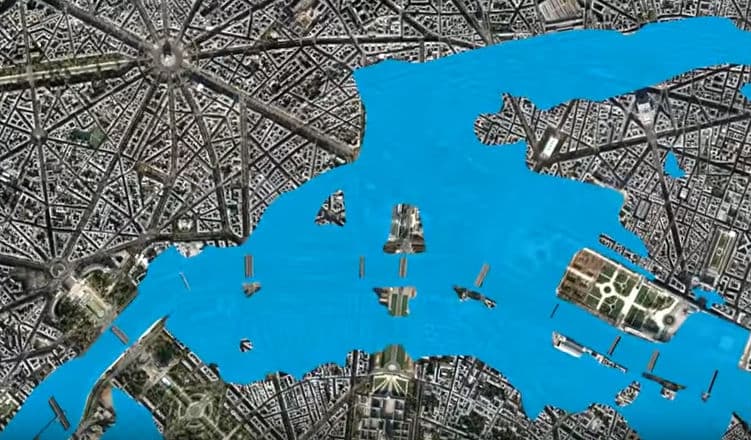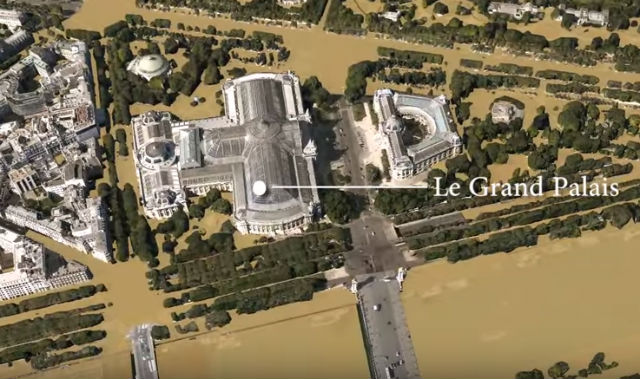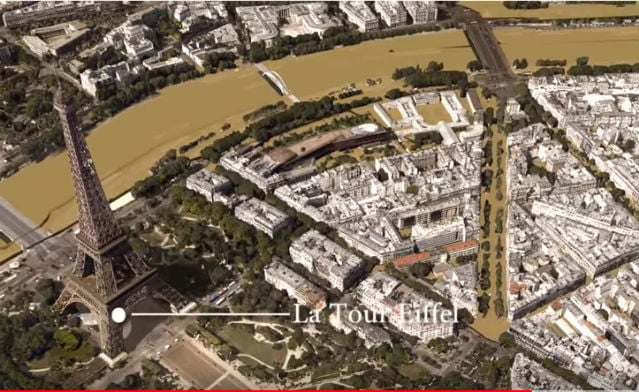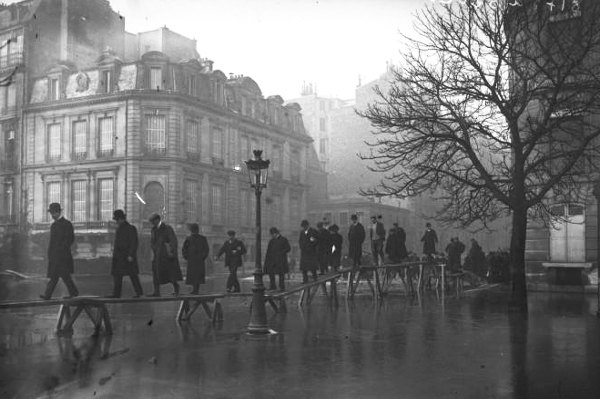'It's just a question of when': Paris still unprepared for inevitable 'flood of the century'

Paris has been hit by another major flood this week, but the real big one is coming, it's just a question of when, experts say. The problem is the French capital and in particular the surrounding area remains unprepared and there would be catastrophic consequences.
“We will have a '100-year-flood'. That’s for sure. The only question is when. A really big flood would last between 10 and 20 days, during which time we wouldn’t be able to do anything, except survive."
“And any return to normal couldn’t be expected before 45 days."
These were the words of Serge Garrigues, the then secretary general of the Paris Defence Zone speaking back in 2013.
In September that year two alarming reports, one by the OECD, concluded that Paris was one of the world cities most at risk from a catastrophic flood because officials were simply not prepared
More, much more, needed to be done to protect the capital's inhabitants and economy from a repeat of the 1910 so-called 'flood of the century'.
“The probability of a major flooding of the Seine, akin to [The Great Flood of Paris in] 1910, can’t be neglected, when you look at what’s at stake and the vulnerability of people and assets now located in flood-prone parts of Ile-de-France, a flood of that nature would directly and indirectly affect five million citizens, and numerous businesses,” the report claimed.
 (Simulated image of Paris if a repeat of the 1910 flood occurs. IAU)
(Simulated image of Paris if a repeat of the 1910 flood occurs. IAU)

Given that the Paris area accounts for one third of France’s economic activity, such a catastrophe “would have a significant national impact on a macro economic level,” the report added.
In the Paris area of Ile-de-France some 435,000 homes, 830,00 people, 100,000 establishments and 750,000 jobs would be directly at risk in the case of a major flood.
Paris transport authorities RATP say if Paris was hit by a "100-year flood" then some 45 percent of the Metro and RER network would close for several days or even weeks. National rail transport would also be hit at Paris's major rail stations.
There would be chaos on road networks, which would hamper the emergency response and delivery of supplies. Electricity supplies would be hit as would the availability of clean drinking water given that the main drinking water production plants are located along the Seine, Marne and Oise rivers, as are sanitation and waste-water treatment plants.
If the 1910 flood occurred again – the chances are said to be 1/100 each year (hence the reason why it's called a '100-year-flood') – then the Paris region's Urban Planning Institute (IAU) estimates the cost to the region could be €20 billion. The OECD puts the estimated cost at €30 billion.
According to the OECD, what was preventing proper preparations for a “flood of the century” was bureaucratic overlap and a lack of communication between national, regional and local operations which are placing the Paris area at risk.
But that 2013 OECD report may have had an impact on authorities in the French capital.
Since 2014 City Hall in Paris has been regularly bringing together around 15 operators to discuss and prepare a response to a catastrophic flood.
 (The great flood of 1910)
(The great flood of 1910)
In March 2016, just months before the major flood of June that year, they held an unprecedented two-week exercise to simulate what would happen if the French capital was hit by a catastrophic flood.
The simulation imagined a scenario where much of the Metro system was underwater, as well as a major train station, the Louvre gallery inundated, nearly one million homes submerged and millions of rats fleeing flooded sewers and basements.
“This is the first time an exercise of this scale has been carried out over a region the size of Ile-de-France,” said Jean-Paul Kihl, secretary general of the Paris security and defense zone, who led the exercises with the aim of making them “as true to life as possible”.
“It will help us improve coordination between the state, local authorities and the business world, but it will also make the public more aware. Because this will happen and so we need to prepare for it,” he said at the time.
As part of the exercise, Metro stations were walled up and sealed off to keep the water away from the platforms, radio stations sent out alerts, prisoners were evacuated from a detention centre and Paris's Musée d'Orsay shifted all its art works to a safe place.
Hundreds of police and firefighters took part in the exercise as did the city's hospitals, transport organizations and the electricity provider EDF.
To give an idea of the how the nightmare scenario would affect the capital, the IAU produced a series of 3D animated videos.
"Today we've made major advances in our knowledge of the risks and consequences of a major flood," Ludovic Faytre, from the IAU told The Local on Thursday.
"The problem is the more we advance the more complex it becomes. It's a major challenge. There are multiple actors working on preparations," he said.
"We've made a lot of progress in the last 15 years."
"We can't avoid the flood, we can just limit the consequences," said Faytre.
As the flood waters were rising in Paris this week the OECD produced a follow up report to their alarming 2013 study.
The think-tank concluded that improvements had been made in recent years but more are needed to manage the major flood risk in the Paris and the Seine basin.
"Urban and territorial planning needs to be better adapted, governance strengthened and long-term funding clarified", according to the OECD although "progress had been made in understanding the vulnerabilities and reinforcing a culture of risk prevention".
This week's flood, which is set to surpass the level of that of 2016, which left four dead and €1.4 billion in damages, will at least be a reminder of the risks and vulnerabilities. But Paris, with a "flood of the century" now overdue, needs to act now rather than later.
Despite four dams being built in the Seine basin since that 1910 flood more needs to be done says the mn who caried out the OECD report.
"Paris is still unprepared for the flood of the century," Charles Baubion, OECD Risk Management Policy analyst told The Local. "But at least they are starting think seriously about it."
Baubion says Paris is less prepared than most major cities and in particular the surrounding suburbs which he says are particularly vulnerable due to the lower level of protection from floods.
"We really need to move into a higher gear and see some concrete results," Baubion said adding that infrastucture must be built, such as new reservoirs and building bigger dykes in the suburbs. Money must be put forward to pay for the work that needs to be done to enable to the city to continue to function in the case of a major flood.
All actors, whether businesses or hospitals, local authorities and ordinary citizens must improve their emergency planning," he says.
"At the end of the day this 'flood of the century' will happen one day," he said.
Comments
See Also
“We will have a '100-year-flood'. That’s for sure. The only question is when. A really big flood would last between 10 and 20 days, during which time we wouldn’t be able to do anything, except survive."
“And any return to normal couldn’t be expected before 45 days."
These were the words of Serge Garrigues, the then secretary general of the Paris Defence Zone speaking back in 2013.
In September that year two alarming reports, one by the OECD, concluded that Paris was one of the world cities most at risk from a catastrophic flood because officials were simply not prepared
More, much more, needed to be done to protect the capital's inhabitants and economy from a repeat of the 1910 so-called 'flood of the century'.
“The probability of a major flooding of the Seine, akin to [The Great Flood of Paris in] 1910, can’t be neglected, when you look at what’s at stake and the vulnerability of people and assets now located in flood-prone parts of Ile-de-France, a flood of that nature would directly and indirectly affect five million citizens, and numerous businesses,” the report claimed.
 (Simulated image of Paris if a repeat of the 1910 flood occurs. IAU)
(Simulated image of Paris if a repeat of the 1910 flood occurs. IAU)

Given that the Paris area accounts for one third of France’s economic activity, such a catastrophe “would have a significant national impact on a macro economic level,” the report added.
In the Paris area of Ile-de-France some 435,000 homes, 830,00 people, 100,000 establishments and 750,000 jobs would be directly at risk in the case of a major flood.
Paris transport authorities RATP say if Paris was hit by a "100-year flood" then some 45 percent of the Metro and RER network would close for several days or even weeks. National rail transport would also be hit at Paris's major rail stations.
There would be chaos on road networks, which would hamper the emergency response and delivery of supplies. Electricity supplies would be hit as would the availability of clean drinking water given that the main drinking water production plants are located along the Seine, Marne and Oise rivers, as are sanitation and waste-water treatment plants.
If the 1910 flood occurred again – the chances are said to be 1/100 each year (hence the reason why it's called a '100-year-flood') – then the Paris region's Urban Planning Institute (IAU) estimates the cost to the region could be €20 billion. The OECD puts the estimated cost at €30 billion.
According to the OECD, what was preventing proper preparations for a “flood of the century” was bureaucratic overlap and a lack of communication between national, regional and local operations which are placing the Paris area at risk.
But that 2013 OECD report may have had an impact on authorities in the French capital.
Since 2014 City Hall in Paris has been regularly bringing together around 15 operators to discuss and prepare a response to a catastrophic flood.
 (The great flood of 1910)
(The great flood of 1910)
In March 2016, just months before the major flood of June that year, they held an unprecedented two-week exercise to simulate what would happen if the French capital was hit by a catastrophic flood.
The simulation imagined a scenario where much of the Metro system was underwater, as well as a major train station, the Louvre gallery inundated, nearly one million homes submerged and millions of rats fleeing flooded sewers and basements.
“This is the first time an exercise of this scale has been carried out over a region the size of Ile-de-France,” said Jean-Paul Kihl, secretary general of the Paris security and defense zone, who led the exercises with the aim of making them “as true to life as possible”.
“It will help us improve coordination between the state, local authorities and the business world, but it will also make the public more aware. Because this will happen and so we need to prepare for it,” he said at the time.
As part of the exercise, Metro stations were walled up and sealed off to keep the water away from the platforms, radio stations sent out alerts, prisoners were evacuated from a detention centre and Paris's Musée d'Orsay shifted all its art works to a safe place.
Hundreds of police and firefighters took part in the exercise as did the city's hospitals, transport organizations and the electricity provider EDF.
To give an idea of the how the nightmare scenario would affect the capital, the IAU produced a series of 3D animated videos.
"Today we've made major advances in our knowledge of the risks and consequences of a major flood," Ludovic Faytre, from the IAU told The Local on Thursday.
"The problem is the more we advance the more complex it becomes. It's a major challenge. There are multiple actors working on preparations," he said.
"We've made a lot of progress in the last 15 years."
"We can't avoid the flood, we can just limit the consequences," said Faytre.
As the flood waters were rising in Paris this week the OECD produced a follow up report to their alarming 2013 study.
The think-tank concluded that improvements had been made in recent years but more are needed to manage the major flood risk in the Paris and the Seine basin.
"Urban and territorial planning needs to be better adapted, governance strengthened and long-term funding clarified", according to the OECD although "progress had been made in understanding the vulnerabilities and reinforcing a culture of risk prevention".
This week's flood, which is set to surpass the level of that of 2016, which left four dead and €1.4 billion in damages, will at least be a reminder of the risks and vulnerabilities. But Paris, with a "flood of the century" now overdue, needs to act now rather than later.
Despite four dams being built in the Seine basin since that 1910 flood more needs to be done says the mn who caried out the OECD report.
"Paris is still unprepared for the flood of the century," Charles Baubion, OECD Risk Management Policy analyst told The Local. "But at least they are starting think seriously about it."
Baubion says Paris is less prepared than most major cities and in particular the surrounding suburbs which he says are particularly vulnerable due to the lower level of protection from floods.
"We really need to move into a higher gear and see some concrete results," Baubion said adding that infrastucture must be built, such as new reservoirs and building bigger dykes in the suburbs. Money must be put forward to pay for the work that needs to be done to enable to the city to continue to function in the case of a major flood.
All actors, whether businesses or hospitals, local authorities and ordinary citizens must improve their emergency planning," he says.
"At the end of the day this 'flood of the century' will happen one day," he said.
Join the conversation in our comments section below. Share your own views and experience and if you have a question or suggestion for our journalists then email us at [email protected].
Please keep comments civil, constructive and on topic – and make sure to read our terms of use before getting involved.
Please log in here to leave a comment.